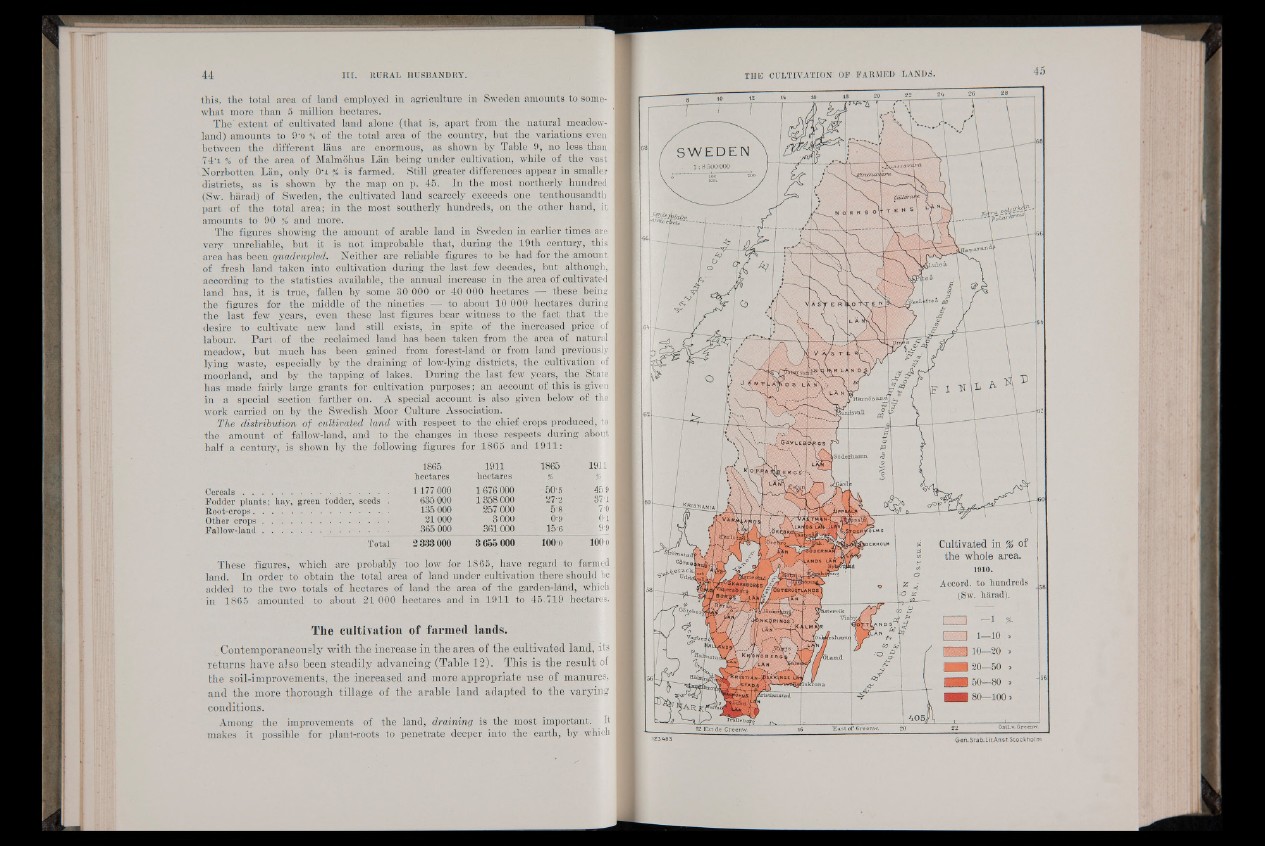
this, the total area of land employed in agriculture in Sweden amounts to somewhat
more than 5 million hectares.
The' extent of cultivated land alone (that is, apart from the natural meadow-
land) amounts to 9’0 % of the total area of the country, but the variations even
between the different Ians are enormous, as shown by Table 9, no less than
74’1 % of the area of Malmohus Lan being under cultivation, while of the vast j
Norrbotten Lan, only 0’4 % is farmed. Still greater differences appear in smaller
districts, as is shown by the map on p. 45. In the most northerly hundred
(Sw. harad) of Sweden, the cultivated land scarcely exceeds one tenthousandth !
part of the total area; in the most southerly hundreds, on the other hand,, it .
amounts to 90 % and more.
The figures showing the amount of arable land in Sweden in earlier times are
very unreliable, but it is not improbable that, during the 19th century, this I
area has been quadrupled. Neither are reliable figures to be had for the amount
of fresh land taken into cultivation during the last few decades, but although,
according to the statistics available, the annual increase in the area of cultivated
land has, it is true, fallen by some 30 000 or 40 000 hectares — these being !
the figures for the middle of the nineties — to about 10 000 hectares during
the last few years, even these last figures bear witness to the fact that the j
desire to cultivate new land still exists, in spite of the increased price jof ;
labour. Part - of the reclaimed land has, been taken from the area of natural,]
meadow, but much has been gained from forest-land or from land previously
lying waste, especially by the draining of low-lying districts, the cultivation of
moorland, and by the tapping of lakes. During the last few years, the State j
has made fairly large grants for cultivation purposes; an account of this is gifen ;
in a special section farther on. A special account is also given below of tie |
work carried on by the Swedish Moor Qulture Association.
The distribution of cultivated land with respect to the chief crops producedfto
the amount of fallow-land, and to the changes in these respects during about
half a century, is shown by the following figures for 1865 and 1911:
Cereals
Root-crops.
Other crops
Fallow-land
1865 1911 1865 1911
hectares •hectares % B
1177 000 1 676 000 50’5 fi:h 45 9
seeds . 635 000 1358 000 27-2 n
135 000 257 000 5'8 7'0
21000 3 000 0-9 HOT
365 000 361000 15-6 9-9
Total 2 333000 3655 000 lotto lOttO
These figures, which are probably too low for 1865, have regard to farmed1
land. In order to obtain the total area of land under cultivation there should be
added to the two totals' of hectares of land the area of the garden-land, which
in 1865 amounted to about 21 000 hectares and in 1911 to 45.719 hectares. ]
The cultivation of farmed lands.
Contemporaneously with the increase in the area of the cultivated land, its
returns have also been steadily advancing (Table 12). This is the result of
the soil-improvements, the increased and more appropriate use of manures,
and the more thorough tillage of the arable land adapted to the varying
conditions.
Among the improvements of the land, draining is the most important. It
makes it possible for plant-roots to penetrate deeper into the earth, by which 1.23483 Gen. S tab. Li t Ansr. S tockhol m